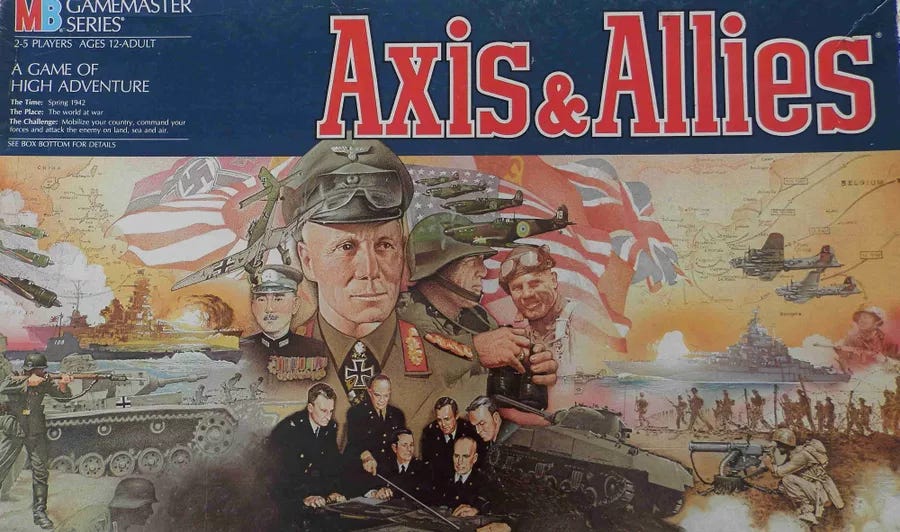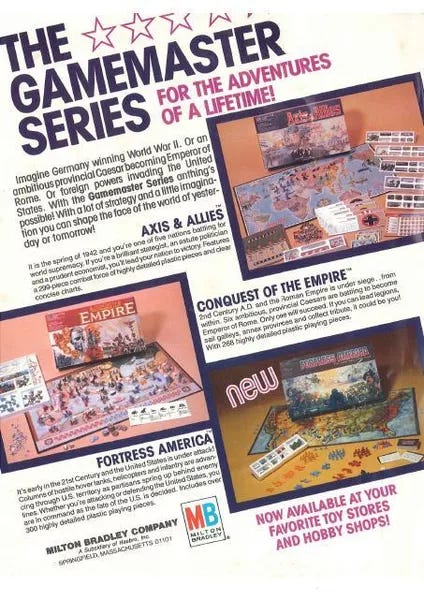As a teenager, walking through the mall’s toy shop felt nostalgic, not exciting. I didn’t care for most of what they offered. Still, I preferred window shopping there to being marched around a department store. But I no longer played with toys. I liked games; “the Toy Store” had precious few, and those for children.
Cootie and other titles for little kids were obviously of no interest. Classics like Monopoly, Risk, Scrabble and Life were fine; but we already had those. Looking for games in a toy store was usually an exercise in disappointment.
But not always. One holiday season the toy store displayed a new series of games; games in big boxes, not suitable for your little cousins. Awe-inspiring. Serious.
OK, not too serious; plastic miniatures (of men, tanks, ships and plane) and mini poker chips to count them; combat involved not-quite-buckets of dice but a high number. Not quite serious, but not childish — players managed budgets, decide how much to spend on units and how much to risk on R&D and there was some negotiation and coordination. This wasn’t a free-form game like Risk where you attacked whoever was winning (or who you felt like attacking). There were teams. War has rules. Players decided which enemy to attack, or which ally would be the sacrificial lamb.
Larry Harris Jr’s Axis and Allies bridged the gap between “games are for children” and the 1970s wargaming industry with paper maps, hex and counters, and daunting rules. Axis and Allies was more complicated than Risk, but not so complicated as to be daunting. And — like Risk — it looked great on the table. Your plastic miniatures just begged to be pushed around with croupier sticks, like they did in real wars in the movies!
We didn’t have a croupier stick, but that didn’t stop my high school gaming group from fighting WWII across an afternoon or weekend, imitating bad Soviet Accents and saying “11 TANK Divisions!” like a Bond villain when said tanks rolled across the border.1
Axis and Allies was a monster hit — not at first when Nova Games published it in 1981 but when it was re-issued with excellent production values by Milton Bradley, who made it palatable to toy shops around the nation.2 That first Christmas was a bounty, because along side Axis and Allies there were two other initial entries in MB’s ‘Gamemaster Series’ — Conquest of the Empire (covering Ancient Rome) and Broadsides and Boarding Parties (Ship to ship combat), both also by Larry Harris Jr. Two years later, the series added two more titles by Michael Gray: Fortress America (a kind of “Red Dawn” / Invasion US scenario) and Shogun3 (Japan! Ninjas!).
All five games in the series were squarely aimed at High-School-Me, but found broad appeal across a wide demographic of gamers. They were all beautifully made and — for the most part — perfectly sound games4. If they are too long now, well, I no longer have the free time I did in High School; I now prefer more complex games — well, they were the gateway.
The Gamemaster series hit at just the right moment (at least for me), and Axis and Allies in particular keeps getting reprinted and re-imagined. The early 2000s saw A&A: Europe, A&A:Pacific. D-Day. The Battle of the Bulge, Guadalcanal. And on and on. (And zombies!) Depending on how you count somewhere around two dozen titles. Because Axis and Allies is not only a fine game, but a fine game-system. Aesthetics matter, too. There is nothing wrong with nice-looking miniatures instead of paper chits, even if the chits let you handle more details.
(Still no croupier stick, though).
There are arguments to be made for several of MB’s Gamemaster Series, but Axis and Allies is clearly the five star general of the bunch: spawning dozens of direct descendants and still seeing play to this day. While I haven’t played in 30+ years and have no desire to revisit it, my memories of that game are formative. Still, I don’t think this is just personal nostalgia when I believe that Axis and Allies is a first-ballot entry into the Top 100 Most Influential Games of the 20th Century.
Note — No new entry next week. In the meantime, if you have a BGG account and wish to vote, you can visit The 20th Century Project Geeklist and vote on the games I’ve already covered to show whether you agree with their inclusion or not.
Which I naturally looked up and found on youtube.
I had not known the Milton Bradley edition was a reprint until I started researching this article. In fact
Later called Ikusa, which for some reason is the name BGG likes.
Even at the time, Conquest of the Empire seemed under-developed, with Catapults being the only real path towards victory. And while I played the other four titles, I never tried Broadsides and Boarding Parties, so I don’t know about it.





